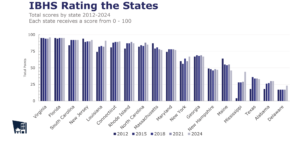It seems like InsurTech has become the term du jour over the last nine months. It is often used to imply destruction, disintermediation, disruption and disaster (the four Ds) for the insurance industry.
Executive Summary
“Do your customers really care about underwriting and product differences, or is this something you think they should care about?”Insureon CEO Ted Devine invites carriers to rethink their priorities regarding product and customer experiences. He also urges them to understand the benefits of putting marketing and distribution functions together and the power of machine learning applications in insurance and other businesses.
I don’t believe any of this to be true. The agents aren’t dead, the brokers aren’t going away, and the carriers will be the primary source of capital for decades to come.
At the same time, technology, data and machine learning are changing the insurance industry in fundamental ways. This change is happening at an ever-increasing rate, which I expect to continue. It will not slow down, and it won’t go away. Those carriers that don’t intelligently embrace and leverage these ideas will put their companies at a significant disadvantage. More simply put: There will be winners and losers, and the firms that best leverage these new tools and technologies will be the winners.
Insureon works with most of the leading carriers every day, leveraging these new technologies. As a result, we have learned three simple things that we hope will help our carrier partners.
1. Understand That Your Product Is NOT Insurance. It’s the Customer Experience
I’ve sat in carrier meetings for years and listened to them explain the most granular underwriting difference that they believe sets their company’s products apart from those of their competitors. In each of these meetings, I always think two things:
- Do your customers really care about this, or is this something you think they should care about?
- Even if it’s a good idea, won’t it take your competitors less than a year to copy you?
Coverage, price and features of your products are important for an agent, broker or direct business, but the customer experience is more than this. These are the questions I think carriers should ask themselves:
- Does your website truly make the buying process as simple as possible?
- Does the application use chatbots and machine-learning tools to guide customers through the buying process?
- Are your underwriters easy to contact, and are they trying to help your clients win?
- Are you constantly using external data and advanced linear statistics to shorten your application to just a handful of core elements?
Think about the frustration you have felt with your customer interactions in other industries. For example, airlines are not just about the price of the tickets and the route. It’s about issues like:
- Is the plane on time?
- Can you reach an agent to change your flight when the weather is bad?
- How easy is it to book a ticket on the website?
- How are you treated by the airline crew?
It’s the end-to-end customer experience that matters in the airline industry, and it’s the same with insurance.
2. Forget What You Know About Distribution and Marketing. Take a Lesson From Online Retailers
Today, not many of us would probably want to invest in a physical retailer because sales are on the decline for many brick-and-mortar stores. Much of that downturn has been driven by their thinking about distribution and marketing as separate elements of customer delivery.
This is how carrier interactions work today with agents and brokers. Marketing is typically a home office function, while distribution “goes out to the field” to talk with distributors. The two are completely separate.
This is not how Amazon, Venmo or Zillow think about their funnel. Marketing and distribution are one function—even if they have physical distribution. They leverage the latest digital tools to constantly improve customer delivery. This is often accomplished through the product management function by:
- Leveraging world-class designers to develop their website.
- Using A/B testing to improve the user experience rather than outdated focus groups.
- Using advanced network marketing techniques to understand how a customer moves across multiple access channels—from the net and emails to calls and physical interactions. Remember, no customer today is uni-channel.
To reinforce this idea, this week (like every week), I will have a carrier come to our office. They will give me a formal presentation and present the numbers. I will think:
- What makes your firm different than the others?
- Do you know how my agents are working with your website? (What is their dropoff rate or conversion rate?)
- Are you testing different front ends to improve these metrics?
- How are you helping my agents use digital tools?
- Do you understand the end customer so you can help me grow?
The winning carriers get it and already are moving in this direction.
3. Advanced Data, Machine Learning and Amazon Web Services Are Here—and They Are Game-Changers
When IBM’s Deep Blue computer beat the world chess champion, machine learning got my attention. When a machine-learning app won in Go with its millions of strategic options, I was very interested. But when you delve into how machine learning is being used across every industry, it’s inspiring.
We see restocking algorithms that not only reorder when inventories are running low, they evaluate weather patterns and the entire value chain to automatically order supplies in real time. There are trading models that have replaced the best statisticians at the largest hedge funds in the world, and machine learning models help financial advisers give the best advice, even as the markets and the client’s risk portfolio change.
In insurance, the applications are almost limitless. Chatbots guide agents and customers through applications. Voice transcription and AI models improve the quality of any conversation. Machine learning models evaluate the riskiness of a portfolio in real time. Optical Character Recognition and crawlers with matching algorithms streamline document processing.
In our view, every element of the insurance business system will be affected by machine learning over the next five years.
The use of external data sources and computer power and software architecture offered by Amazon Web Services will amplify this impact. For example, at Insureon, we can now run our machine learning models in real time with our agency management system, run functional testing every two minutes to make sure every one of our 250 micro-services cells are working properly and release 50-100 improvements to the system every night at 8 p.m. None of this would have been possible even five years ago.
Again, we do not believe InsurTech will fundamentally disrupt the industry. But we do believe that every day the latest technology, data and machine learning techniques have the opportunity to make our firm better. The winning carriers will do this in ways that we can’t even imagine, and that is the power of InsurTech.





















 Travelers: Distracted Driving Incidents Continue to Rise
Travelers: Distracted Driving Incidents Continue to Rise  Cat Losses, Auto and HO Price Hikes Continue at Allstate
Cat Losses, Auto and HO Price Hikes Continue at Allstate  Survey: Majority of CA/FL Homeowners See Rise in Insurance Costs, Coverage Changes
Survey: Majority of CA/FL Homeowners See Rise in Insurance Costs, Coverage Changes  That Insurance Talent Crisis? It’s a Global Knowledge Opportunity
That Insurance Talent Crisis? It’s a Global Knowledge Opportunity 

